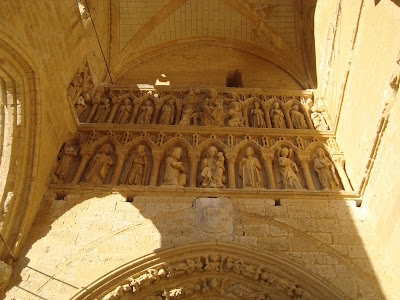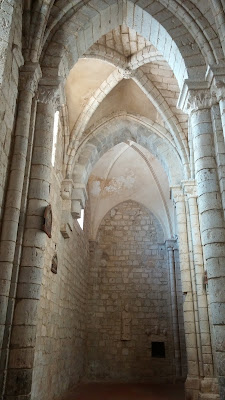 |
| The south facade of Santa Maria la Blanca, Villalcázar de Sirga Photos in this post 2019 Jessica Knauss |
"There's a miracle-working Virgin there," I said. "The Cantigas mention her a lot." As shown in the previous post, there are no fewer than fourteen cantigas (3 percent!) telling only some of the miracles the Virgin Mary performed in the thirteenth century in what was then known as Villasirga.
 |
| Fifteenth-century castle at Olmillos de Sasamón |
 |
| The view from the pub, with Christmas decor |
Before the redo trip two weeks later, I read all the Villasirga cantigas and got a sense of the awesome power concentrated here. We learned that the "sirga" in the town's name refers not just to any road, but to the type of road that follows along a canal. Given that it's named for a place of transit, Villasirga has always been a site of reference for travelers. Perhaps for that reason, it is the only town to the north of the Duero River that belonged to the Order of the Knights Templar. As was their custom, they set up a hospital and hostel for weary travelers here. In the early thirteenth century, after an artist created the image of the Blessed Virgin, the town was able to compete for the massive traffic along the pilgrims' Road to Santiago. It was at that time that the Church of Santa Maria la Blanca was built, to honor this Virgin Mary and give her a grand space in which to work her miracles.
The star attraction outside is this double set of porticoed doors in the south facade, uniquely set against each other at a 90-degree angle. Although the archways are very similar in style, the leftmost door was made first as the grand entrance near the foot of the church, following Romanesque convention. The doors greet us with angels, priests, saints, and musicians. The way the figures are positioned within the arch tends toward Gothic, as is the slight point at the top. In the fourteenth century, the Chapel of Santiago was added to the transept area, and the rightmost door is a direct entry into that chapel.
Over the leftmost archway, there's a lovely double late-Romanesque frieze. On top, we have a Christ in Majesty with the symbols of the Gospel writers ("tetramorphos," they're called) and then what were intended to be the twelve apostles spreading out on either side. On the left, two apostles extend into the next wall, while on the right, two apostles are missing. They likely existed for about a hundred years, and were removed when the new wall for the Santiago Chapel was built. Below, there's a lovely Epiphany scene, with the Virgin and Child in the center and the Magi to the left. To the right, Joseph stands in the first archway, and the final two contain the angel Gabriel making the Annunciation, and the Virgin Mary receiving the news with an appropriate degree of surprise mixed with surrender implied in her hand gesture.
 |
| Note the painted column capitals! |
As I've hinted above, the construction is Romanesque-Gothic transition, so although it's built like a fortified structure with few windows, it's also voluminous. When you walk in, the whole space is illuminated through the rose window in the Santiago Chapel, and you can't help but look up at the pointed arches undulating through the upper space.
Figures and heads from the fallen door are indeed found within the church...
... and in other buildings. These thirteenth-century kingly faces are set into the facade of the nineteenth-century town hall.
Knowledge of these construction events and interventions is necessary to understand the unexpected question I had to deal with on this auspicious day:
Which Virgin?
Most tour guides take for granted that the above pictured is the Virgin of the Cantigas. She certainly has the look: early Gothic symmetry and a placid expression dominate the symbols of this lady's important role in Heaven and on Earth, and the colors that emphasize her beauty are nothing if not Alfonsine. It was so widely accepted in the nineteenth century that this is the Virgin who worked the medieval miracles that she was placed in the Santiago Chapel to watch over the magnificent thirteenth-century tombs of none other than Prince Felipe, the younger brother of King Alfonso X, and his second wife.
However, reputable art sites and references admit that this might not be that Virgin after all. This Virgin is stone, which isn't the customary material for a devotional image of the thirteenth century. I mentioned that she was moved to the Santiago Chapel--from where? From the Puerta del Ángel. During the time of Alfonso X, this Blessed Mother was outside the church, possibly hanging over people's heads as they came through the door. None of the cantigas in her honor talk about stopping to pay respects outside the church. On the contrary, they mention going inside the church to an altar to pray or hear mass or even sleep. None of these activities has the remotest chance of taking place in the doorway. To me, this means that this stone Virgin, even as Alfonsine as she appears, cannot possibly be the Virgin of the Cantigas.
As you can see, as we entered the church, we studied the beauty of the Santiago Chapel and I had my picture taken with the likely spurious Virgin. But I was only too pleased to settle into a pew and listen to mass because from there, I could unabashedly stare at the thirteenth-century Virgin Mary in the center of the main altarpiece. This, I believe, is the real deal, the beautifully sculpted Mother of God that moved a king so deeply, he had fourteen songs written about her.
She's similar in style and symbolism to the Santiago Chapel Virgin and just as symmetrical and placid, but she's made of wood. She was always an indoor Mary. For this reason, she still has her right hand and Baby Jesus still has his head. She's now surrounded by a magnificent fifteenth-century Hispano-Flemish series of panels depicting the life of Jesus.
We listened to the whole mass, and the sermon appropriately focused on the way Mary saved the day by noticing that they were running out of wine at the wedding at Cana. Mary had a talent for staying on top of the details when no one else would, said the priest. Every one of us has a special God-given talent, and we must do our duty and let it shine. I felt a tremendous sense of abundance and joy as I considered how to make my talents matter in the world.
During the part of the mass when the congregation gives each other "God's peace," the priest came into the aisle and shook everyone's hand and even chatted a little before returning to his post to finish. This is the first time I've seen such a warm and welcoming act. It felt like a sign of cosmic approval for the decisions I've made up to this point.
 |
| Romanesque fantastic creatures, but the execution is Gothic |
 |
| Peter with the keys to the pearly gates |
 |
| You can get a sense of the grand scale looking toward the foot. |
 |
| The stone Virgin is dwarfed in the light from the rose window. |
"I can tell!" he said.
Just one more miracle from Villalcázar de Sirga.













Hola Jessica it's March13,2021 and I'm in the process of organizing the photos I took on the El Camino in 2019. I fondly remember Villalcazar De Sirga. I stayed in the Albergue just across the cafe/bar from where you took a picture of the Santa Maria La Blanca through the Cafe's window...cool. The size of the Templar Church was mesmerising. I got some photos of the stork nests high up the back of the church. I also enjoyed Carrion de Los Condes. I'm reliving my El Camino journey by going through my photos. I really appreciated your write up and photos.
ReplyDeleteThanks, Carl
ps I'm from Los Angeles, California
Thanks for reading and for your lovely comment! Buen Camino!
Delete